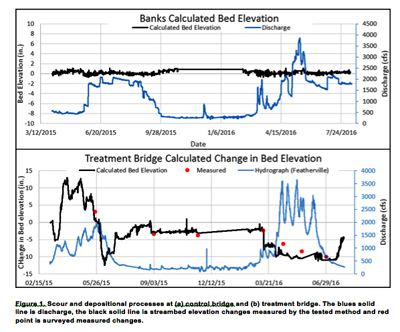
Using stream and streambed temperature sensors to monitor bridge-foundation erosion shows promise as low-cost method
Scour -- the removal of the sediment around bridge piers and footings by fast-moving water – can compromise the stability of bridge piers, levee foundations, or structure footings. Monitoring scour condition is vital for timely and effective detection of problems. Figuring out how to combat scour is a top priority for ITD and for transportation departments nationwide.
A recent discovery by ITD's Scour Team may indicate an answer to the problem.
Current methods for scour detection, including ring rods, acoustic or sonar technology, can be costly, impractical or too complicated. Limitations in cost and difficulty in deployment can make it cumbersome to obtain reliable results. New technologies that provide affordable, real-time data on scour deposits are highly desired.
The ITD Scour Committee funded research through the Research Program to test a new methodology using naturally occurring daily temperature fluctuations in stream water to monitor scour at bridge piers. The method uses temperature sensors buried in the streambed and one in the surface water. The thicker the wall in a home, the larger the difference between the outside and inside temperatures. The same principle is applied here — more sediment is expected when the difference in temperatures is large between the sensor in the stream and that in the sediment.
Two bridges in southwest Idaho were used in the investigation, and provided positive results. A "control" bridge was located near the town of Banks, and a "treatment" bridge was located on the South Fork of the Boise River. There was no scour expected at the control bridge, while deposition and scour was expected at the treatment bridge. Analysis of amplitude and time lag between the temperature signals measured in the surface water and in the streambed provided the verification of these suppositions.
"In fact, the results show that the streambed was very dynamic during the year," said ITD Scour Committee project manager Jake Legler of Bridge Asset Management. "The maximum erosion occurred at the onset of the high flows, followed by the depositing of sediment. This suggests that cross-section survey collected during low flows before and after high flows may show less erosion than what may really occur," he explained. 
Legler is the ITD project manager for the research following the retirement of Lotwick Reese, the state's hydraulic engineer. The Technical Advisory Committee includes Scour Committee members Tri Buu, Dan Gorley, Bryan Martin and Luis Zarate, Research Program Manager Ned Parrish; and Federal Highway Adminisrtration Bridge Engineer Ed Miltner.
Published 09-23-16